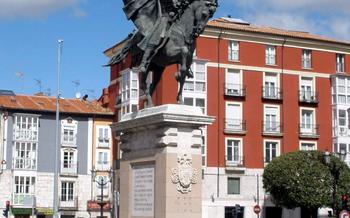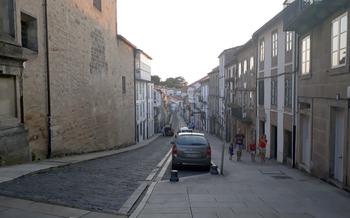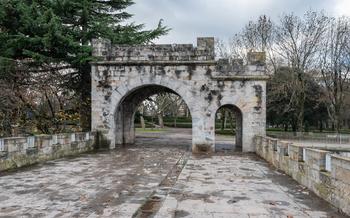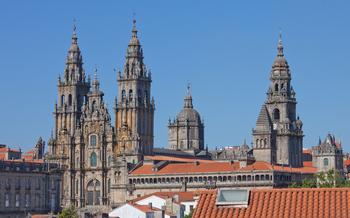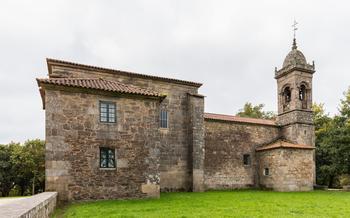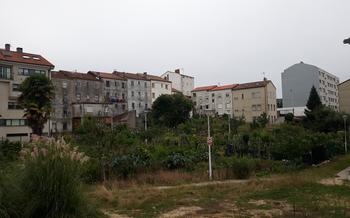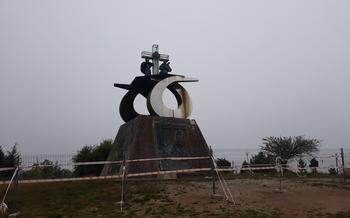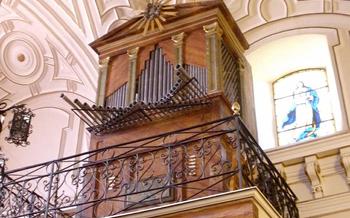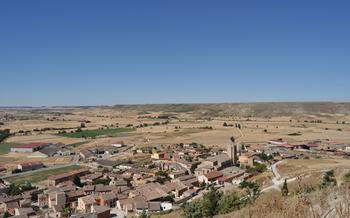
Monasterio de San Juan de Ortega
- Monasterio de San Juan de Ortega: A Timeless Gem in Burgos
- The Founding Legend: San Juan de Ortega and the Miracle of the Hand
- Architectural Masterpiece: Exploring the Romanesque Style
- Artistic Treasures: Unveiling the Monastery's Collection
- Practical Information: Planning Your Visit
- A Stroll Through History: Exploring the Monastery Grounds
- Local Cuisine: Savoring the Flavors of Burgos
- Legends and Mysteries: Unraveling the Enigmas of the Monastery
- Nearby Attractions: Exploring the Region
- Photography Tips: Capturing the Monastery's Beauty
- Souvenirs and Mementos: Preserving Your Memories
- Accessibility for All: Ensuring an Inclusive Experience
- Monastery Events and Activities: Enriching Your Visit
- Insider Tip: Discovering Hidden Gems
Monasterio de San Juan de Ortega: A Timeless Gem in Burgos
Nestled in the heart of the province of Burgos, Spain, lies the Monasterio de San Juan de Ortega, a magnificent testament to the region's rich history and architectural heritage. Founded in the 11th century by the hermit San Juan de Ortega, the monastery has stood the test of time, evolving from a humble hermitage to a flourishing Benedictine abbey. Today, it stands as a national monument, inviting visitors to explore its captivating history, stunning Romanesque architecture, and invaluable collection of art and artifacts.
The Founding Legend: San Juan de Ortega and the Miracle of the Hand
The Monasterio de San Juan de Ortega is steeped in legend and lore, with the story of San Juan de Ortega, the hermit who is said to have performed a miraculous healing, being particularly captivating. According to legend, San Juan de Ortega was a hermit who lived in a cave near the site of the current monastery. One day, a group of pilgrims traveling along the Camino de Santiago came across San Juan and asked him for help. One of the pilgrims had lost his hand in an accident, and San Juan, moved by their plight, miraculously restored the pilgrim's hand.
The legend of San Juan de Ortega and the miracle of the hand has been passed down through the centuries, becoming an integral part of the monastery's history and identity. The hand motif is a recurring theme in the monastery's iconography and architecture, symbolizing the healing power of faith and the miraculous intervention of San Juan de Ortega.
The local traditions and beliefs surrounding San Juan de Ortega and his legacy are deeply rooted in the culture of the region. The saint is revered as a protector and healer, and his feast day, celebrated on October 1, is a major event in the local calendar. Pilgrims from all over the world come to the monastery to pay homage to San Juan de Ortega and to seek his blessing.
The cultural and religious significance of the legend of San Juan de Ortega extends far beyond the boundaries of the monastery. It is a story that speaks to the power of faith, the importance of compassion, and the enduring legacy of the Camino de Santiago.
Architectural Masterpiece: Exploring the Romanesque Style
The Monasterio de San Juan de Ortega is a stunning example of Romanesque architecture, showcasing the distinctive characteristics of this influential style. As you approach the monastery, its impressive exterior commands attention, featuring elegant facades adorned with intricate carvings and sturdy buttresses that lend a sense of strength and stability. The main entrance, known as the Portada Sur, is a masterpiece in itself, showcasing a series of beautifully preserved sculptures depicting biblical scenes and figures.
Stepping inside the monastery, you'll be awestruck by the vaulted ceilings, graceful arches, and beautifully preserved Romanesque frescoes that adorn the walls. The monastery's interior is a testament to the skill and artistry of the medieval craftsmen who created it. The cloister, with its delicate arcades and serene atmosphere, invites you to pause and reflect on the spiritual significance of this sacred space.
One of the most striking features of the monastery is its use of symbolism. The rose window, located above the main entrance, is a powerful symbol of divine light and represents the connection between heaven and earth. The cloister's capitals, adorned with intricate carvings of plants and animals, convey symbolic meanings related to faith, hope, and charity.
As you explore the monastery, you'll notice the evolution of Romanesque architecture through its various construction phases. The oldest parts of the monastery, dating back to the 11th century, exhibit a simpler and more austere style, while the later additions, from the 12th and 13th centuries, showcase a more elaborate and refined approach. This evolution reflects the changing artistic and cultural influences that shaped the development of Romanesque architecture over time.
Artistic Treasures: Unveiling the Monastery's Collection
Frescoes:
The Monasterio de San Juan de Ortega is home to a remarkable collection of well-preserved medieval frescoes, which adorn the walls of the church and other spaces within the monastery. These frescoes, dating from the 12th and 13th centuries, depict biblical scenes, the life of San Juan de Ortega, and other religious imagery. The vibrant colors and intricate details of these frescoes offer a glimpse into the artistic and religious traditions of the medieval period.
Sculptures:
The monastery also boasts a collection of exquisite sculptures, which can be found throughout the building. These sculptures, carved from stone and wood, depict various religious figures, including the Virgin Mary, Jesus Christ, and the apostles. The sculptures are notable for their expressive faces, graceful postures, and intricate details, demonstrating the skill and artistry of the medieval craftsmen who created them.
Relics:
In addition to its artistic treasures, the Monasterio de San Juan de Ortega houses a number of significant religious relics. Among these relics are fragments of the True Cross, which are believed to have been brought to the monastery by San Juan de Ortega himself. The relics are displayed in a special reliquary within the church, and they attract pilgrims and visitors from around the world.
Contemporary Art:
In recent years, the monastery has also become home to a collection of modern art, which is displayed in a dedicated gallery space. This collection features works by renowned Spanish artists, such as Antonio Saura and Manolo Millares. The inclusion of contemporary art in the monastery's collection reflects its commitment to preserving and promoting artistic expression in all its forms.
Practical Information: Planning Your Visit
Location: The Monasterio de San Juan de Ortega is situated in the province of Burgos, in the autonomous community of Castile and León, Spain. It is located in the town of San Juan de Ortega, approximately 25 kilometers southeast of the city of Burgos. To get there, you can take the N-120 road or the A-1 motorway, followed by the BU-820 provincial road.
Hours and Admission: The monastery is open to the public from Tuesday to Sunday, with varying hours depending on the season. During the summer months (June to September), it is open from 10:00 to 18:00, while in the winter months (October to May), it is open from 10:00 to 14:00 and 15:30 to 17:30. Admission fees vary, with reduced rates for children, students, and seniors. Guided tours are available for an additional fee and can be arranged in advance.
Facilities: The monastery offers a range of facilities for visitors, including a parking area, restrooms, and a gift shop. There is also a cafe where you can purchase refreshments and snacks. The monastery is wheelchair accessible, and there are designated areas for visitors with disabilities.
Accessibility: The Monasterio de San Juan de Ortega is committed to providing an inclusive and accessible experience for all visitors. The monastery is wheelchair accessible, and there are designated areas for visitors with disabilities. Guided tours that cater to visitors with special needs or disabilities can be arranged in advance. Additionally, there are various sensory experiences available, such as touch tours and audio descriptions, to help visitors with disabilities engage with the monastery's history and culture.
A Stroll Through History: Exploring the Monastery Grounds
As you wander through the monastery grounds, you'll be captivated by the serene atmosphere and rich history that surrounds you. Begin your exploration in the cloister, a peaceful oasis with graceful arches and lush greenery. Take a moment to sit on one of the benches and soak in the tranquility, imagining the monks who once walked these same paths.
Next, step into the charming garden, a riot of colors and fragrances. Admire the variety of plants and flowers, from delicate roses to fragrant lavender. From here, you'll be rewarded with stunning views of the surrounding countryside, a patchwork of fields, forests, and distant hills.
Pay your respects to past pilgrims and monks at the monastery's cemetery, where simple tombstones mark their final resting place. Reflect on the lives of these individuals who dedicated themselves to faith and community.
Finally, venture to the archaeological site adjacent to the monastery. Here, you can explore the remains of earlier structures and settlements, providing a glimpse into the monastery's long and storied past.
Local Cuisine: Savoring the Flavors of Burgos
Burgos boasts a rich culinary tradition, and a visit to the Monasterio de San Juan de Ortega offers an opportunity to sample some of the region's most delectable dishes.
Morcilla de Burgos, a type of blood sausage, is a local specialty known for its unique flavor and texture. Queso de Burgos, a soft, fresh cheese, is another must-try, often served with honey or fruit. Olla podrida, a hearty stew made with chickpeas, meat, and vegetables, is a traditional dish that showcases the region's culinary heritage.
Beyond these local specialties, Burgos offers a diverse range of culinary delights to satisfy every palate.
You can find fresh, seasonal produce at local markets, along with a variety of artisanal products such as honey, cheese, and wine. Whether you prefer to dine at a traditional restaurant or sample local delicacies at a tapas bar, you'll find plenty of options to tantalize your taste buds.
To fully immerse yourself in the local cuisine, consider taking a cooking class and learning how to prepare some of the region's signature dishes yourself.
This is a great way to bring a taste of Burgos back home with you and impress your friends and family with your newfound culinary skills.
Legends and Mysteries: Unraveling the Enigmas of the Monastery
The Monasterio de San Juan de Ortega is steeped in legends and mysteries that have captivated visitors for centuries. One of the most enduring legends is that of the hidden treasures supposedly buried within the monastery grounds. Some believe that a vast fortune in gold and jewels was hidden by the monks during the Middle Ages to protect it from invaders. Treasure hunters have scoured the monastery and its surroundings for centuries, but no one has ever found the hidden riches.
Another legend tells of ghostly apparitions and unexplained phenomena associated with the monastery. Visitors have reported seeing the ghost of San Juan de Ortega himself wandering the grounds, and some claim to have heard strange noises and seen mysterious lights in the dead of night. Whether these stories are true or not, they add an air of intrigue and mystery to the monastery, making it a fascinating place to visit.
The monastery is also surrounded by ancient curses and superstitions. One legend tells of a monk who was cursed to wander the monastery grounds for eternity after breaking his vows. Another story tells of a terrible plague that was brought upon the monastery by a group of witches who were seeking revenge. These tales of curses and superstitions have been passed down from generation to generation, adding to the mystique of the Monasterio de San Juan de Ortega.
Nearby Attractions: Exploring the Region
Beyond the monastery's walls, the province of Burgos offers a wealth of captivating destinations to complement your visit. Embark on a journey through time as you explore the enchanting historic towns and villages that dot the region. Santo Domingo de Silos, renowned for its magnificent Romanesque abbey, and the picturesque village of Covarrubias, with its medieval charm and well-preserved architecture, are just a few of the gems waiting to be discovered.
Immerse yourself in the region's natural wonders, from the dramatic landscapes of the Hoces del Rio Lobos Canyon, a haven for outdoor enthusiasts and nature lovers, to the majestic peaks of the Sierra de la Demanda mountains, inviting you to embark on scenic hikes and explore hidden trails.
For a taste of the region's rich culinary traditions, venture into the local wineries and vineyards, where you can sample the renowned wines of Burgos and learn about the region's winemaking heritage. Participate in local festivals and events throughout the year, such as the medieval market in Santo Domingo de Silos, where you can experience the vibrant culture and traditions of the region firsthand.
Photography Tips: Capturing the Monastery's Beauty
Best Angles:
- For capturing the monastery's majestic exterior, position yourself in the courtyard or across the Plaza de San Juan de Ortega to capture the full grandeur of the Romanesque facade.
- To showcase the intricate details of the portal, zoom in on the carvings and sculptures that adorn the entrance.
- For interior shots, find angles that highlight the vaulted ceilings, elegant arches, and beautifully preserved frescoes.
Lighting Conditions:
- Early morning or late afternoon light provides the best conditions for photography, as the warm, golden hues enhance the monastery's architectural features.
- Avoid harsh midday sun, as it can create harsh shadows and overexposed areas.
- If possible, visit on a clear day to take advantage of the natural light.
Composition and Perspective:
- Experiment with different compositions to create visually appealing images. Try using leading lines, such as the arches of the cloister, to draw the viewer's eye into the frame.
- Play with perspective by shooting from different angles, such as from a low vantage point to emphasize the monastery's towering height.
Photography Etiquette:
- Be respectful of the monastery's sacred nature and avoid using flash photography inside the church.
- If you encounter any religious ceremonies or services, be mindful of the ongoing proceedings and avoid causing disruptions.
- Always ask for permission before photographing people, especially monks or pilgrims, to ensure their privacy.
Souvenirs and Mementos: Preserving Your Memories
Capture a piece of your Monasterio de San Juan de Ortega experience with unique souvenirs. The monastery's gift shop offers a range of items, from books and postcards to religious artifacts and local handicrafts. Support the local economy by purchasing handmade souvenirs from artisans in the region, showcasing the region's rich artistic traditions.
Indulge your taste buds with local delicacies like cheeses, wines, and sweets. These culinary delights will not only satisfy your cravings but also serve as delicious reminders of your visit. If you're a pilgrim, don't forget to collect your credential (pilgrim's passport) and stamps at the monastery. These treasured mementos will document your journey along the Camino de Santiago, a testament to your spiritual and physical pilgrimage.
Accessibility for All: Ensuring an Inclusive Experience
The Monasterio de San Juan de Ortega is committed to providing an inclusive and accessible experience for all visitors, regardless of their abilities or needs. The monastery is wheelchair accessible, with ramps and elevators available to facilitate movement throughout the complex. Guided tours that cater to visitors with special needs or disabilities can be arranged upon request. Additionally, the monastery offers a variety of sensory experiences, such as touch tours and audio descriptions, to help visitors with visual or hearing impairments engage with the monastery's history and culture. The staff at the monastery is dedicated to providing assistance and support to ensure that all visitors have a fulfilling and enriching experience.
Monastery Events and Activities: Enriching Your Visit
In addition to its historical and architectural significance, the Monasterio de San Juan de Ortega offers various events and activities to enhance your visit. Check the monastery's website or inquire locally to find out about upcoming concerts, recitals, or performances that take place within the monastery's hallowed halls. These events provide a unique opportunity to experience the monastery's acoustics and atmosphere while enjoying high-quality artistic performances.
Temporary exhibitions and workshops are also held throughout the year, showcasing the monastery's rich history, art, and culture. These events offer a deeper dive into specific aspects of the monastery's heritage and provide insights into the lives of the monks and pilgrims who have passed through its doors.
If you're visiting during the pilgrimage season, be sure to participate in the special events and celebrations honoring San Juan de Ortega and the Camino de Santiago. These events may include processions, masses, and other festivities that bring the monastery's spiritual significance to life.
Finally, the monastery offers educational programs and guided visits designed for school groups or families with children. These programs provide interactive and engaging ways for younger visitors to learn about the monastery's history and cultural importance.
Insider Tip: Discovering Hidden Gems
Unravel the mysteries of the Monasterio de San Juan de Ortega by venturing beyond the well-trodden paths. Seek out the elusive secret passageways hidden within the monastery walls, and if you're lucky, you might stumble upon their concealed entrances. Ascend to the rooftop for an awe-inspiring panorama of the surrounding countryside and the distant mountain peaks. Delve into the monastery's lesser-known corners, such as the chapter house or the scriptorium, where hidden treasures await discovery. Engage with the locals, the true custodians of the region's secrets, and ask for their recommendations for nearby hidden gems and off-the-beaten-path experiences. These insider tips will unlock a deeper and more fulfilling connection with the monastery and its rich history.

